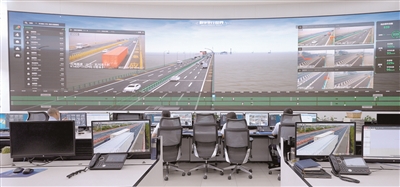
The bridge command center goes digital. Photo by Fan Hong
Traffic control plans can be implemented within seconds to warn drivers of an accident ahead; detailed traffic flows can be displayed on digital screens to broadcast real-time traffic information on the bridge. Hangzhou Bay Bridge has been a pioneer in remapping all-weather roads with vision-based digital twin technology, rendering it China’s first “digital twin sea-crossing bridge”.
前方车辆发生事故,管控信息数秒内完成发布,提醒后方车辆注意规避;数字诱导屏“车道级”显示,精准反映全桥实时动态。日前,国内首个基于纯视觉的全天候高速公路数字孪生应用在杭州湾跨海大桥建成。这也标志着,杭州湾跨海大桥成为国内首座“数字孪生跨海大桥”。
As the journalists from Ningbo Evening News walked into the command center, a large screen with a virtual Hangzhou Bay Bridge on it came into view. Real-time data, incidents and images, the BeiDou Navigation Satellite System, traffic congestion, and response work on the bridge were all displayed. The comprehensive and dynamic information assessment means that any changes to the traffic environment are updated and digitally analyzed to implement adaptive traffic management plans.
走进大桥指挥中心,硕大的屏幕上,一座“数字孪生大桥”呈现在“云端”,这座桥上汇聚了杭州湾跨海大桥上实时流量、事件图文、北斗导航、通阻状况、处置进展等关键要素,实现全信息要素和实时车流轨迹展示。在这里,桥面上发生的各种细微动态和变化,都可以被实时掌握,并进行数字化分析,等待下一步管理指令调整与发布。
Along the bridge, digital high-definition cameras with AI are spaced 125 meters in an orderly manner, each of which monitors both lanes, guaranteeing full coverage of the traffic conditions.
再到大桥桥面上,支持AI事件检测的数字高清摄像机,全桥双向间距125米一个,布设密集有序。这些视觉设备单个就可覆盖双向车道,保障着大桥感知能力实现100%全覆盖。
Digital Twin is a simulation technology that integrates multidisciplinary, multi-physical quantity, multi-scale and multi-probability through fully analyzing physical models, sensors, operating history and other data to realize mapping in the cloud or meta-universe, which then digitally reflects the whole life cycle of the physical object. Therefore, it can be interpreted as building a “twin bridge” synchronized with the physical bridge in a replicated virtual environment.
“数字孪生”是一种超越现实的概念,它是充分利用物理模型、传感器、运行历史等数据,集成多学科、多物理量、多尺度、多概率的仿真过程,在云端或元宇宙环境中实现映射,从而数字化地反映相对应的实体装备的全生命周期。可以理解为在虚拟环境中,构建了一座和现实环境中同步的“孪生大桥”。
Based on this technology, a digital model of the Hangzhou Bay Bridge has been built to monitor and update the dynamics of traffic, including real-time traffic flow, infrastructure and other road conditions. 108 strategies for 18 types of accidents across the bridge are thus in place. For example: What is the exact location of the rear-end collision? Are emergency assistance and temporary lane closure required? How many lanes are occupied because of the accident? How should the vehicles behind avoid the crashed vehicles?
基于这项“数字孪生”技术,整个大桥的数字化模型得以构建,涵盖了实时车流、结构设施、通阻状态等信息,全桥动态一览无遗。在此基础上,杭州湾跨海大桥完成了全桥18类事件108种管控策略的编制部署,比如:桥上发生了车辆追尾等交通事故,这个事故究竟发生在什么位置?是否需要紧急救援及封道?事故占用几条车道?后方车辆应该如何避让?
How are traffic alerts and predictions conveyed to vehicles and passengers on the bridge, then? Hangzhou Bay Bridge provides full coverage of accurate traffic guidance services. Smart devices including 1,828 sets of intelligent fog lights, 40 full-color screens, and 346 sets of directional digital early warning broadcast equipment make it possible to complete news-producing processes within 10 seconds, allowing passengers to access accurate and timely information about road conditions.
那么,这些信息如何传递给正在桥上通行的车辆和司乘人员呢?杭州湾跨海大桥实现了全桥精准交通诱导服务,通过桥上1828套智能雾灯、40处全彩诱导屏、346套定向数字预警广播等智能设备,可在10秒内完成从智能发现、策略匹配到发布的全过程,使司乘人员通行过程中准确、及时地获取大桥路况信息。
Every 2 seconds, a car drives over the Hangzhou Bay Bridge. It serves as a highway bridge connecting the eastern coast of Zhejiang province to Shanghai, as well as Suzhou, Wuxi and Changzhou in Jiangsu province, saving 15 billion yuan in the social costs of energy consumption.
每2秒就有一辆车驶过,从浙江东部沿海到上海、苏锡常地区实现高速公路直连,累计减少社会能耗成本150亿元。
Zhu Mei, deputy general manager of Ningbo Communications Investment Holdings Co., Ltd. and president of Ningbo Hangzhou Bay Bridge Development Co., Ltd., praised digital transformation of the bridge. In the first half of 2022, the accident rate dropped by 16.4% year on year, and the secondary accident rate decreased by 66% year on year. Meanwhile, 99% of incidents can be detected with rescue forces arriving at the scene within 20 minutes. Hangzhou Bay Bridge, which opened to traffic nearly 15 years ago, has embarked on a new journey of digitalization.
宁波交投副总经理、杭州湾大桥公司董事长朱梅告诉记者,通过数字化改造,今年上半年,杭州湾跨海大桥事故发生率同比下降16.4%,二次事故率同比下降66%,事件检测发现率达99%,施救力量抵达现场时间缩短至20分钟以内。已通车近15年的杭州湾跨海大桥,由此迈入了数字化时代的新征程。
Reporter: Fan Hong
Correspondents: Zhang Xue’er and Xie Wei
Translator: Mei Jie
Proofreaders: PuYang Rong, Zhou Shiyi, Jason Mowbray


